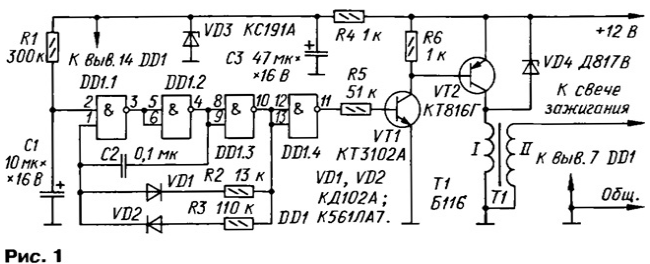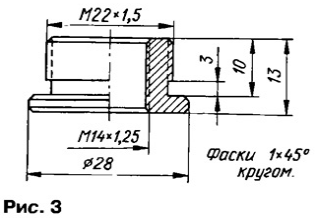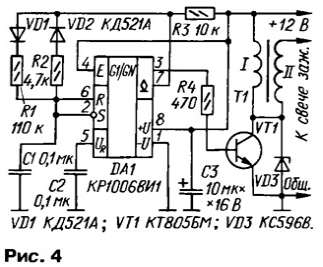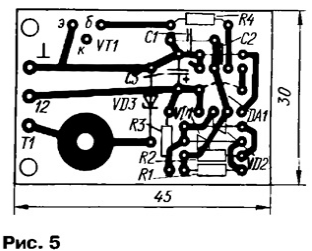Many owners of cars "Zaporozhets" in the winter time you have to spend expensive battery amp-hours for ignition heater. This can be avoided, if you equip the heater electronic control unit described below.
Petrol heater car "Zaporozhets" in the ignition mode current consumption about 10 A. It leads to a significant discharge of the battery. Such waste even in summer it would be undesirable, and in winter it can become obstacle when starting the engine.
More economical electronic ignition unit heater, collected by the circuit Fig. 1. The unit consumes a current of about 0.1 A. the Heater with electronic control unit fueled almost instantly.

The pulser assembled logic elements DD1.1-DD1.3, operates at a frequency of about 70 Hz. The pulse duration of working the low level at the output of the generator is about 1 MS, duty cycle - 10. Element DD1.4 - inverter.
Transistors VT1, VT2 collected current amplifier, loaded primary winding ignition coil T1. During the working of the high level pulse from the output of inverter transistors VT1 and VT2 are open and dense. Through the primary winding the current flows, the value of which is determined by the settings of the ignition coil.
At the moment minus the voltage drop on the base of the transistor VT1 both transistors closed and the secondary winding of the ignition coil high voltage occurs a voltage pulse that causes spark discharge between the electrodes of a spark the candles. The Zener diode VD4 protects the power transistor from the return pulses the voltage of self-induction of the primary winding of the ignition coil and the too a large forward voltage arising at break high voltage circuit.
DD1 chip is powered by a parametric voltage regulator with VD3R4 a smoothing capacitor C3. The circuit R1C1 provides delay the start of work generator with about 2 to purge heater.
Work duration of the pulse (1 MS) selected minimally sufficient for the ignition coil was time to accumulate the necessary energy sparking. This provided a high efficiency unit.
The device is assembled on a circuit Board made of fiberglass with a thickness of 1.5 mm. Drawing Board depicted in Fig. 2.

Board is placed in a durable plastic box. When the Assembly of the unit should take measures to protect it from dust and moisture. The power to the unit arrives on the wire which was connected to the spark plug still heater.
In block applied resistors MLT-0,125, capacitors K53-19 (S1), K53-14 (C3) and Km-6 (C2). Diodes VD1, VD2 and the transistor VT1 can be used any low-power silicon. Instead CTG suitable CTA-CTV, CTA - CTV; preference should be given more voltage. The ignition coil can be any battery from the ignition system, for example, B112, B.
Spark plugs - any car with a short thread. To install it on the heater is to fabricate the bushing of steel, brass (or bronze). The drawing of the sleeve in Fig. 3. Spark gap of the spark is better to increase up to 1 ...2 mm.

Multiple instances of the described ignition module work reliably for several years on "the Cossacks" by the Way this petrol heaters equipped some automobile cranes, and such a block for them would be no superfluous.
In Fig. 4 shows a diagram of a variant of the ignition unit is assembled on the basis of integrated circuit timer CREW. The timer is enabled in the mode of the pulse generator a frequency of 70 Hz (pulse width 1 MS, duty cycle - 10). Transistor VT1 - current amplifier.

The unit is assembled on a printed circuit Board (Fig. 5) of foiled fiberglass 1.5 mm thick.

Capacitors C1, C2 from the km, C3 - K53-19. Instead transistor KTM suitable CHEM. Zener XV can be replaced by XG, XV.
Author: B. Slepchenko, Navashino, Nizhny Novgorod region






